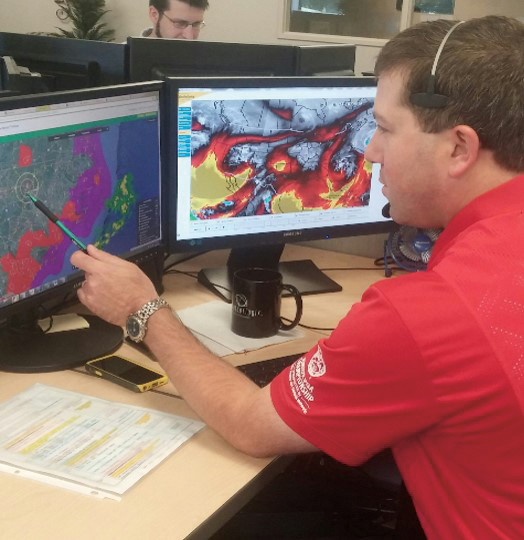Larger utilities typically spend significant dollars to contract with professional weather services, especially to be better prepared to restore power after storms. Why, with all the good free weather available from the National Weather Service and free (ad-based) weather, is that still the case? If you’re a small to medium sized co-op or municipality using free weather, what are you missing? What’s the value of a weather service geared to serve utility needs? Is free weather actually costing you?
In this article, we’ll focus on the benefits of working with a service to improve your storm response. A professional weather service can have value for day-to-day operational planning, and more value on the load/generation side of things, but the greatest return on investment is around better staffing decisions before storms. It’s not just basic forecasts of wind or thunderstorms. How severe will the weather really be? Timing is critical for making potentially costly decisions about holding crews over, putting crews on call overnight or over the weekend. Make the wrong decision and you can waste a lot of money in unused crews, or have a real PR disaster in a poor storm response because you weren’t adequately prepared.
For utilities, there are three reasons why a professional weather service is extremely valuable over free weather:
- Lightning data
- Meteorological consulting
- Specialized services and products designed for utilities
We’ll look at each of these, and then put it all together.
Lightning Data is Key
Mapping of real-time lightning strikes is very valuable for making near-term decisions about the impact an approaching storm may have and the number of crews that may be needed. There is a strong correlation between the amount of lightning and the winds that can be expected. So, not only does display of each lightning strike show if you may have outages due to lightning itself but it also helps indicate the severity of wind damage you can expect. Free weather services either have no lightning data, delay the lightning, or use backyard hobbyist sensors that can’t be relied upon.
Professional services can issue lightning alerts. This is valuable if you’re a small utility without 24/7 weather monitoring. And during restoration, for safety when thunderstorms re-develop, lightning alerts can even be sent directly to the phones of crews, using their GPS position, so dispatchers don’t have to monitor weather for the crews.
Historical lightning data is also valuable. Some professional services allow you to overlay lightning strike position against your infrastructure – such as your substations – on the map too. While other services even generate automated reports for inspections. This provides a list of substations to inspect after a storm if a strike occurred in close proximity. The strike may have caused damage but not an outage and this enables you to detect and fix the issue before an unexpected major failure occurs. The exact time of strike is included and that can be correlated to faults or other outage or SCADA data. Professional services include amplitude and polarity to help you identify strikes that are more likely to cause damage.
Professional Meteorological Consulting is Especially Helpful to Utilities
Even as weather models and resulting forecasts continuously improve, a human being still adds much value to a utility. First, weather models do a great job with temperature and are getting better with precipitation probability. But severe weather, especially high winds, not so much. Weather models tend to under-forecast high winds. This is especially the case several days out. An experienced meteorologist adds significant value when you most need it. They can adjust the forecast or give you other guidance about what to really expect.
Meteorological consulting is especially helpful in understanding your risk. What’s the likelihood of the event being significantly worse than what’s forecasted? How much worse? Usually it is prudent to staff for not just the most likely scenario, which is what a weather forecast is. So what is the realistic worst case for this event? Tricky and particularly concerning events like ice storms are another example of the value of consulting with a meteorologist. Very small changes in the forecast can mean the difference between rain and ice. You have a lot riding on your decisions and the support of a weather professional who really understands not only the weather but also the decisions you need to make is invaluable.

Consulting or meteorological input can take many forms. It can be a forecast specially prepared for you. It can be phone consulting when you need it. It can be question and answer consulting online. It can be a storm briefing or briefings before a storm. Forecasts can be aligned to your service territory divisions (how you geographically organize your work). And they can take into account operational considerations such as various actions you take at forecasted wind speed thresholds.
Experienced meteorologists who work with utilities understand these things and factors such as leaves on trees results in a more severe impact. Or that soil saturation can come into play and make a major wind event even more major.
Free weather gives you none of these benefits. Utilities that use high quality meteorological consulting come to trust and deeply rely upon these people. They’re like an extension of your staff, 24/7.
Products Geared to Power Utilities
We’ve just talked about people – professional meteorological support. Now let’s talk product. Professional weather service products offer many features useful to utilities including features specifically designed for utilities.
Some professional products can display utility service territory boundaries, transmission lines, substations, and other infrastructure, so you can see weather in the context of your utility. You may also be able to import custom layers.
Tools to gage distance and time of arrival of a storm, help you with more precise crew callouts. Some products provide indicators of impending severe weather in addition to radar and lightning – indicators like severe storm cells or corridors. And local storm reports from weather spotters or other on-the-ground observers.
Automated alerts can watch the weather for you – and give alerts for way more than just NWS bulletins. Alerts can give you a heads up on forecasted or current weather conditions of concern to you, based on your specific thresholds.
After the storm, professional tools can provide various types of historical data for post-storm analysis and reporting to management.
Some weather services have features specifically for display on a large monitor in your operations center or control room, continuously cycling through various saved views.
And in the mobile world of your crews, you should also be able to get these professional features on apps on your phone.
So Much More than Just Getting a Forecast
Yes, free weather keeps getting better – but the paid weather services keep getting better too. So whether it’s lightning data, meteorological consulting, or specialized product features, a professional weather service brings enormous value to the operations side of the utility business. If you’re trying to get by using free weather, now you know what you’re missing. With so much riding on preparing for power restoration – expensive crews, your reputation with customers, executive management’s expectations around time of restoration and more – a professional weather service is an excellent investment.
 Don Leick is the senior product manager for DTN’s weather business. He leads the future direction and enhancement of online, mobile and alerting products. He’s been the product manager for the WeatherSentry product for most of his 13 years with the company. Leick has extensive experience working with many of DTN’s customer segments including utilities, wind farms, sports and winter road maintenance.
Don Leick is the senior product manager for DTN’s weather business. He leads the future direction and enhancement of online, mobile and alerting products. He’s been the product manager for the WeatherSentry product for most of his 13 years with the company. Leick has extensive experience working with many of DTN’s customer segments including utilities, wind farms, sports and winter road maintenance.







